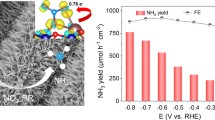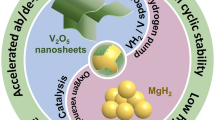Abstract
In2O3 is an effective electrocatalyst to convert CO2 to formic acid (HCOOH), but its inherent poor electrical conductivity limits the efficient charge transfer during the reaction. Additionally, the tendency of In2O3 particles to agglomerate during synthesis further limits the exposure of active sites. Here we address these issues by leveraging the template effect of graphene oxide and employing InBDC as a self-sacrificing template for the pyrolysis synthesis of In2O3@C. The resulting In2O3@C/rGO-600 material features In2O3@C nanocubes uniformly anchored on a support of reduced graphene oxide (rGO), significantly enhancing the active sites exposure. The conductive rGO network facilitates charge transfer during electrocatalysis, and the presence of oxygen vacancies generated during pyrolysis, combined with the strong electron-donating ability of rGO, enhances the adsorption and activation of CO2. In performance evaluation, In2O3@C/rGO-600 exhibits a remarkable HCOOH Faradaic efficiency exceeding 94.0% over a broad potential window of −0.7 to −1.0 V (vs. reversible hydrogen electrode (RHE)), with the highest value of 97.9% at −0.9 V (vs. RHE) in a H-cell. Moreover, the material demonstrates an excellent cathodic energy efficiency of 71.6% at −0.7 V (vs. RHE). The study underscores the efficacy of uniformly anchoring metal oxide nanoparticles onto rGO for enhancing the electrocatalytic CO2 reduction performance of materials.

Similar content being viewed by others
References
Liang, Z.; Song, L. P.; Sun, M. Z.; Huang, B. L.; Du, Y. P. Atomically dispersed indium and cerium sites for selectively electroreduction of CO2 to formate. Nano Res. 2023, 16, 8757–8764.
Zhang, Z. Y.; Bian, L.; Tian, H.; Liu, Y.; Bando, Y.; Yamauchi, Y.; Wang, Z. L. Tailoring the surface and interface structures of copper-based catalysts for electrochemical reduction of CO2 to ethylene and ethanol. Small 2022, 18, 2107450.
Yang, D. R.; Wang, X. 2D n-conjugated metal-organic frameworks for CO2 electroreduction. SmartMat 2022, 3, 54–67
Verma, S.; Kim, B.; Jhong, H. R. M.; Ma, S. C.; Kenis, P. J. A. A gross-margin model for defining technoeconomic benchmarks in the electroreduction of CO2. ChemSusChem 2016, 9, 1972–1979.
Sun, C. Y.; Li, W.; Wang, H. Q. Cascade electrolysis and thermocatalysis: A reliable system for upgrading C1 to C4 hydrocarbons. Rare Met. 2024, 43, 410–412.
Guan, Y. Y.; Zhang, X. R.; Zhang, Y. X.; Karsili, T. N. V.; Fan, M. Y.; Liu, Y. Y.; Marchetti, B.; Zhou, X. D. Achieving high selectivity towards electro-conversion of CO2 using In-doped Bi derived from metal-organic frameworks. J. Colloid Interface Sci. 2022, 612, 235–245.
Yang, X. F.; Wang, Q. R.; Chen, F. R.; Zang, H.; Liu, C. J.; Yu, N.; Geng, B. Y. In-sttu electrochemical restructuring of Cu2BiSx solid solution into Bi/CuxSy heterointerfaces enabling stabilization intermediates for high-performance CO2 electroreduction to formate. Nano Res. 2023, 16, 7974–7981
Gao, J. J.; Shiong, S. C. S.; Liu, Y. Reduction of CO2 to chemicals and fuels: Thermocatalysis versus electrocatalysis. Chem. Eng. J. 2023, 472, 145033.
Jiang, Y. L.; Chen, Q. S.; Wang, D.; Li, X.; Xu, Y. P.; Xu, Z. N.; Guo, G. C. In situ structural evolution of BiOCOOH nanowires and their performance towards electrocatalytic CO2 reduction. Nano Res. 2023, 16, 6661–6669
Wang, S. W.; Gao, Q.; Xu, C.; Jiang, S.; Zhang, M. Y.; Yin, X. J.; Peng, H. Q.; Liu, B.; Song, Y. F. Molecular surface functionalization of In2O3 to tune interfacial microenvironment for enhanced catalytic performance of CO2 electroreduction. Nano Res., in press, https://doi.org/10.1007/s12274-023-6019-x.
Yang, W. F.; Zhao, Y.; Chen, S.; Ren, W. H.; Chen, X. J.; Jia, C.; Su, Z.; Wang, Y.; Zhao, C. Defective indium/indium oxide heterostructures for highly selective carbon dioxide electrocatalysis. Inorg. Chem. 2020, 59, 12437–12444.
Chen, Z. P.; Yu, G.; Li, B.; Zhang, X. X.; Jiao, M. Y.; Wang, N. L.; Zhang, X. P.; Liu, L. C. In situ carbon encapsulation confined nickel-doped indium oxide nanocrystals for boosting CO2 electroreduction to the industrial level. ACS Catal. 2021, 11, 14596–14604
Wang, Z. T.; Zhou, Y. S.; Liu, D. Y.; Qi, R. J.; Xia, C. F.; Li, M. T.; You, B.; Xia, B. Y. Carbon- confined indium oxides for efficient carbon dioxide reduction in a solid-state electrolyte flow cell. Angew. Chem., Int. Ed. 2022, 61, e202200552.
Wulan, B.; Cao, X. Y.; Tan, D. X.; Ma, J. Z.; Zhang, J. T. To stabilize oxygen on In/In2O3 heterostructure via joule heating for efficient electrocatalytic CO2 reduction. Adv. Funct. Mater. 2023, 33, 2209114.
Zhao, X. L.; Huang, M.; Deng, B. W.; Li, K. L.; Li, F.; Dong, F. Interfacial engineering of In2O3/InN heterostructure with promoted charge transfer for highly efficient CO2 reduction to formate. Chem. Eng. J. 2022, 437, 135114.
Shang, H. S.; Zhou, X. Y.; Dong, J. C.; Li, A.; Zhao, X.; Liu, Q. H.; Lin, Y.; Pei, J. J.; Li, Z.; Jiang, Z. L. et al. ngginerrigg unsymmetrically coordinated Cu-S1N3 single atom sites with enhanced oxygen reduction activity. Nat. Commun. 2020, 11, 3049.
Pei, J. J.; Yang, L.; Lin, J.; Zhang, Z. D.; Sun, Z. Y.; Wang, D. S.; Chen, W. X. Integrating host design and tailored electronic effects of yolk-shell Zn-Mn diatomic sites for efficient CO2 electroreduction. Angew. Chem., Int. Ed. 2024, 63, e202316123.
Wang, Q. R.; Yang, X. F.; Zang, H.; Chen, F. R.; Wang, C.; Yu, N.; Geng, B. Y. Metal-organic framework-derived BiIn bimetallic oxide nanoparticles embedded in carbon networks for efficient electrochemical reduction of CO2 to formate. Inorg. Chem. 2022, 61, 12003–12011.
Qiu, C.; Qian, K.; Yu, J.; Sun, M. Z.; Cao, S. F.; Gao, J. Q.; Yu, R. X.; Fang, L. Z.; Yao, Y. W.; Lu, X. Q. et al. MOF-transformed In2O3-x@C nanocorn electrocatalyst for efficient CO2 reduction to HCOOH. Nano-Micro Lett. 2022, 14, 167.
Li, J. Y.; Zhu, M. H.; Han, Y. F. Recent advances in electrochemical CO2 reduction on indium-based catalysts. ChemCatChem 2021, 13, 514–531.
Wang, B. Q.; Chen, S. H.; Zhang, Z. D.; Wang, D. S. Low-dimensional material supported single-atom catalysts for electrochemical CO2 reduction. SmartMat 2022, 3, 84–110.
Zhou, J.; Li, L. Y.; Gao, X. J.; Wang, H. Q. Clusterphene: A new two-dimensional structure from cluster self-assembly. Nano Res. 2022, 15, 5790–5791.
Zang, D. J.; Gao, X. J.; Li, L. Y.; Wei, Y. G.; Wang, H. Q. Confined interface engineering of self-supported Cu@N-doped graphene for electrocatalytic CO2 reduction with enhanced selectivity towards ethanol. Nano Res. 2022, 15, 8872–8879.
Tian, J.; Huang, X. H.; Wu, W. Graphene- based stand-alone networks for efficient solar steam generation. Ind. Eng. Chem. Res. 2020, 59, 1135–1141.
Pan, B. B.; Yuan, G. T.; Zhao, X.; Han, N.; Huang, Y.; Feng, K.; Cheng, C.; Zhong, J.; Zhang, L.; Wang, Y. H. et al. Highly dispersed indium oxide nanoparticles supported on carbon nanorods enabling efficient electrochemical CO2 reduction. Small Sci. 2021, 1, 2100029.
Muschi, M.; Serre, C. Progress and challenges of graphene oxide/metal-organic composites. Coord. Chem. Rev. 2019, 387, 262–272.
Xiao, P. T.; Li, S.; Yu, C. B.; Wang, Y.; Xu, Y. X. Interface engineering between the metal-organic framework nanocrystal and graphene toward ultrahigh potassium-ion storage performance. ACS Nano 2020, 14, 10210–10218.
Qiu, X.; Wang, X.; Li, Y. W. Controlled growth of dense and ordered metal-organic framework nanoparticles on graphene oxide. Chem. Commun. 2015, 51, 3874–3877.
Zhang, J.; Li, Z.; Qi, X. L.; Zhang, W.; Wang, D. Y. Size tailored bimetallic metal-organic framework (MOF) on graphene oxide with sandwich-like structure as functional Nano-hybrids for improving fire safety of epoxy. Compos. Part B: Eng. 2020, 188, 107881.
Volkringer, C.; Meddouri, M.; Loiseau, T.; Guillou, N.; Marrot, J.; Férey, G.; Haouas, M.; Taulelle, F.; Audebrand, N.; Latroche, M. The Kagomé topology of the gallium and indium metal-organic framework types with a MIL-68 structure: Synthesis, XRD, solidstate NMR characterizations, and hydrogen adsorption. Inorg. Chem. 2008, 47, 11892–11901.
Liu, N.; Huang, W. Y.; Zhang, X. D.; Tang, L.; Wang, L.; Wang, Y. X.; Wu, M. H. Ultrathin graphene oxide encapsulated in uniform MIL-88A(Fe) for enhanced visible light-driven photodegradation of RhB. Appl. Catal., B: Environ. 2018, 221, 119–128.
Wang, Y. D.; Ding, J. N.; Zhao, J.; Wang, J. J.; Han, X. P.; Deng, Y. D.; Hu, W. B. Selective electrocatalytic reduction of CO2 to formate via carbon-shell-encapsulated In2O3 nanoparticles/graphene nanohybrids. J. Mater. Sci. Technol. 2022, 121, 220–226.
Li, R.; Sun, L. M.; Zhan, W. W.; Li, Y. A.; Wang, X. J.; Han, X. G. Engineering an effective noble-metal-free photocatalyst for hydrogen evolution: Hollow hexagonal porous micro-rods assembled from In2O3@carbon core-shell nanoparticles. J. Mater. Chem. A 2018, 6, 15747–15754.
Kou, X. L.; Zhang, Y. N.; Niu, D. F.; Han, X. F.; Ma, L. B.; Xu, J. Polyethylene oxide-engineered graphene with rich mesopores anchoring Bi2O3 nanoparticles for boosting CO2 electroreduction to formate. Electrochim. Acta 2022, 433, 141256.
Cao, Z.; Kim, D.; Hong, D. C.; Yu, Y.; Xu, J.; Lin, S.; Wen, X. D.; Nichols, E. M.; Jeong, K.; Reimer, J. A. et al. A molecular surface functionalization approach to tuning nanoparticle electrocatalysts for carbon dioxide reduction. J. Am. Chem. Soc. 2016, 138, 8120–8125.
Qi, Y. H.; Song, L. Z.; Ouyang, S. X.; Liang, X. C.; Ning, S. B.; Zhang, Q. Q.; Ye, J. H. Photoinduced defect engineering: Enhanced photothermal catalytic performance of 2D black In2O3-x nanosheets with bifunctional oxygen vacancies. Adv. Mater. 2020, 32, 1903915.
Ni, W.; Li, C. X.; Zang, X. G.; Xu, M.; Huo, S. L.; Liu, M. Q.; Yang, Z. Y.; Yan, Y. M. Efficient electrocatalytic reduction of CO2 on CuxO decorated graphene oxides: An insight into the role of multivalent Cu in selectivity and durability. Appl. Catal., B: Environ. 2019, 259, 118044.
Huang, Y. D.; Yu, R. T.; Mao, G. Q.; Yu, W. J.; Ding, Z. Y.; Cao, Y. B.; Zheng, J. C.; Chu, D. W.; Tong, H. Unique FeP@C with polyhedral structure in-situ coated with reduced graphene oxide as an anode material for lithium ion batteries. J. Alloys Compd. 2020, 841, 155670.
Shanmugasundaram, A.; Gundimeda, V.; Hou, T. F.; Lee, D. W. Realizing synergy between In2O3 nanocubes and nitrogen-doped reduced graphene oxide: An excellent nanocomposite for the selective and sensitive detection of CO at ambient temperatures. ACS Appl. Mater. Interfaces 2017, 9, 31728–31740.
Zhao, J.; Deng, J.; Han, J.; Imhanria, S.; Chen, K. Y.; Wang, W. Effective tunable syngas generation via CO2 reduction reaction by non-precious Fe-N-C electrocatalyst. Chem. Eng. J. 2020, 389, 124323.
Wang, W. H.; Wang, X. S.; Ma, Z. G.; Wang, Y.; Yang, Z. X.; Zhu, J. X.; Lv, L.; Ning, H.; Tsubaki, N.; Wu, M. B. Carburized In2O3 nanorods endow CO2 electroreduction to formate at 1 Acm−2. ACS Catal. 2023, 13, 796–802.
Zhang, B.; Chang, Y.; Zhai, P. L.; Wang, C.; Gao, J. F.; Sun, L. C.; Hou, J. G. Enriching metal-oxygen species and phosphate modulating of active sites for robust electrocatalytical CO2 reduction. Adv. Mater. 2023, 35, 2304379.
Zhao, Y.; Liang, J. J.; Wang, C. Y.; Ma, J. M.; Wallace, G. G. Tunable and efficient tin modified nitrogen-doped carbon nanofibers for electrochemical reduction of aqueous carbon dioxide. Adv. Energy Mater. 2018, 8, 1702524.
Zhang, A.; He, R.; Li, H. P.; Chen, Y. J.; Kong, T. Y.; Li, K.; Ju, H. X.; Zhu, J. F.; Zhu, W. G.; Zeng, J. Nickel doping in atomically thin tin disulfide nanosheets enables highly efficient CO2 reduction. Angew. Chem., Int. Ed. 2018, 57, 10954–10958.
Wei, G. C.; Zhang, Q. L.; Zhang, D. H.; Wang, J.; Tang, T.; Wang, H. M.; Liu, X.; Song, Z. X.; Ning, P. The influence of annealing temperature on copper-manganese catalyst towards the catalytic combustion of toluene: The mechanism study. Appl. Surf. Sci. 2019, 497, 143777.
Acknowledgements
This work was supported by Joint Key Program of National Natural Science Foundation of China (No. U22B20147).
Author information
Authors and Affiliations
Corresponding authors
Electronic Supplementary Material
Rights and permissions
About this article
Cite this article
Li, W., Gao, S., Yang, C. et al. Enhanced electrocatalytic CO2 reduction to formic acid using nanocomposites of In2O3@C with graphene. Nano Res. 17, 5031–5039 (2024). https://doi.org/10.1007/s12274-024-6517-5
Received:
Revised:
Accepted:
Published:
Issue Date:
DOI: https://doi.org/10.1007/s12274-024-6517-5




